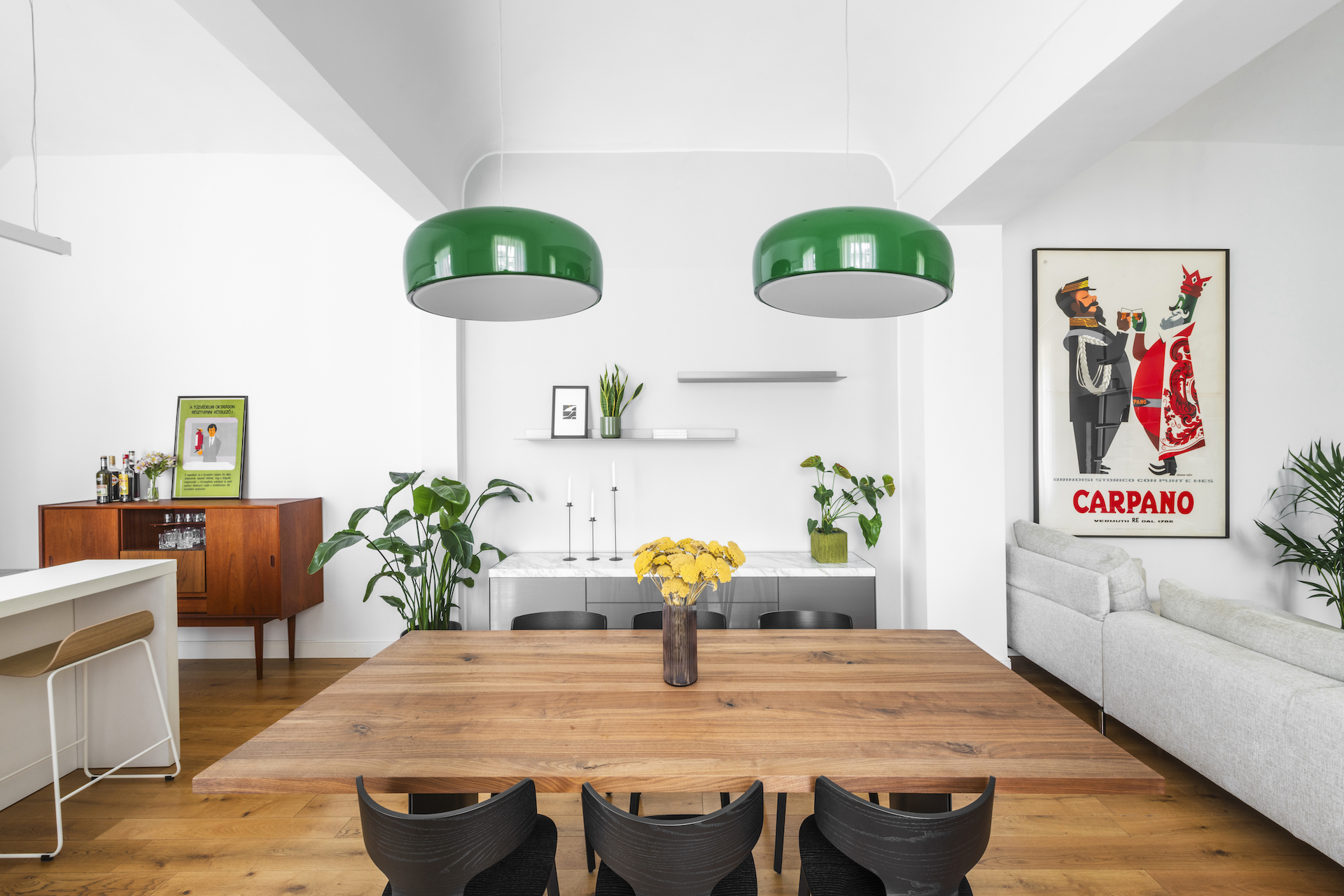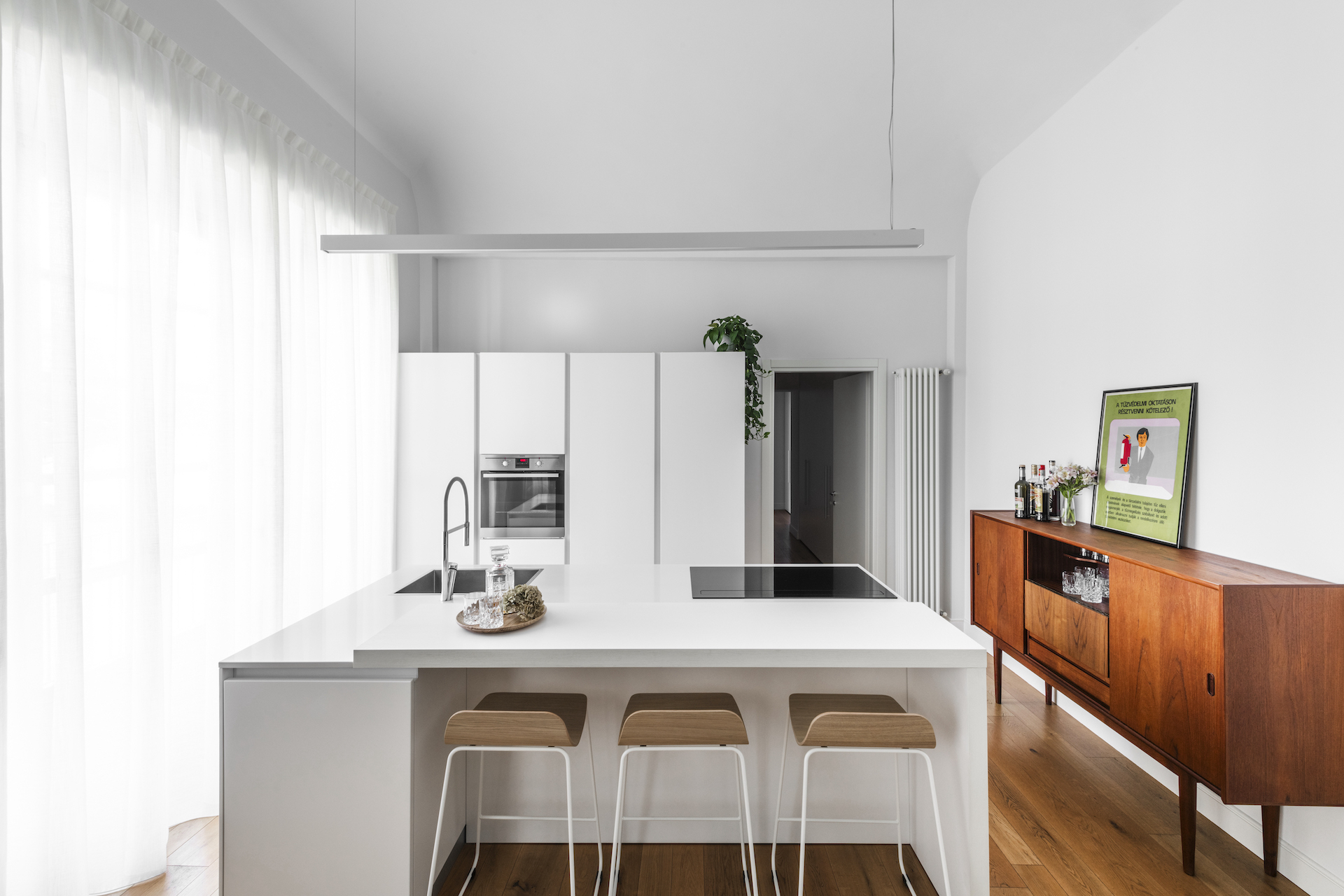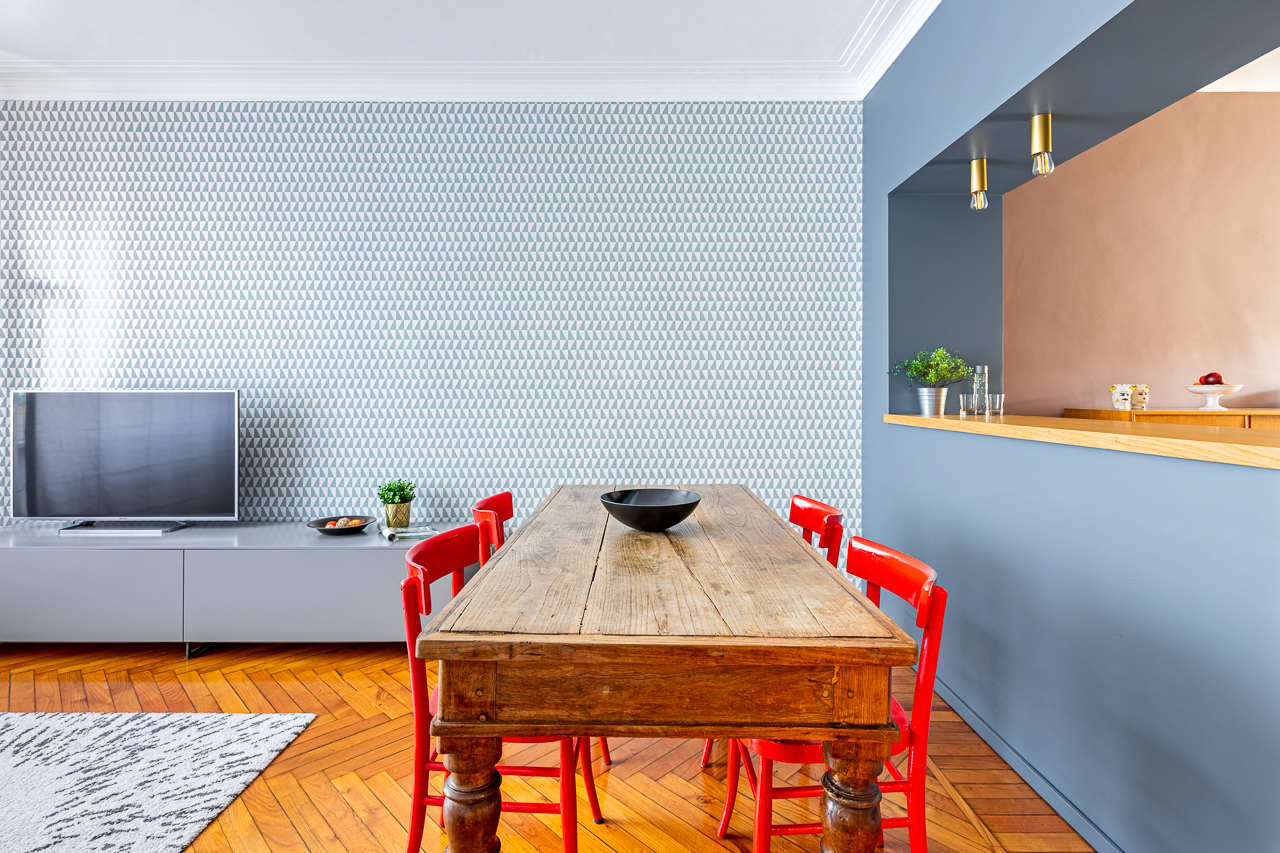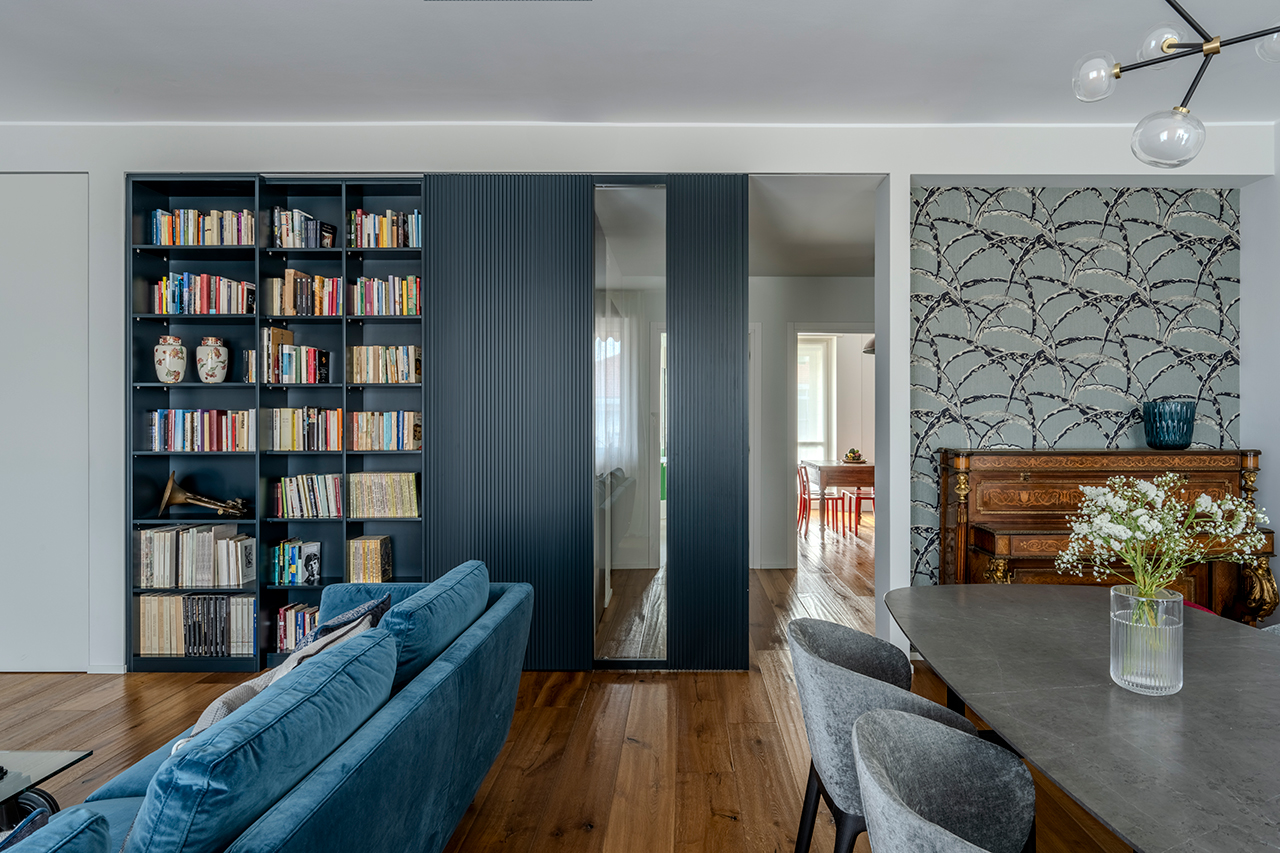Matteo Magnabosco: disegnare case intorno alle persone
From renovation to interior design, architecture becomes a personal narrative of listening, colors, materials and custom choices.
Dalla ristrutturazione all’interior design, l’architettura diventa un racconto personale fatto di ascolto, colori, materiali e scelte su misura
Architecture as a passion. What were and still are your influences/inspirations?
As a child, I had an instant attraction to Lego, the idea of building and creating something new and novel from small elements has always fascinated me. From an early age, my creativity was channeled into architectural projects: houses, castles, fire stations, etc. Anything that had to do with building was of interest to me, carefully following instructions, because precision is an almost innate quality of mine. During my college years at the Faculty of Architecture, I studied the designs of the greats of contemporary architecture, from Frank Lloyd Wright to Le Corbusier. I have always focused my attention on floor plans, small graphic masterpieces that are often not given the attention they deserve. Hence my passion for floor plans, which is still a central part of my work as an interior designer. I find it very interesting to study the different possibilities, to adapt them to the client’s wishes, often with the aim of transforming homes with a few skillful changes that can upset the use of spaces. It is often very easy to design from a blank sheet of paper, but the real challenge is to try to open up new possibilities from the constraints imposed by the floor plan. It is an ever new and stimulating game that starts anew every time a new client comes to the studio with a house to renovate.
Architettura come passione. Quali sono state e sono tutt’ora le sue influenze/ispirazioni?
Da piccolo ho avuto una folgorazione per il Lego, l’idea di costruire e creare qualcosa di nuovo e inedito partendo da piccoli elementi è sempre stata affascinante. La mia creatività però è stata fin da subito incanalata verso progetti architettonici: case, castelli, stazioni dei pompieri, etc. Tutto ciò che prevedeva edifici da costruire era di mio interesse, seguendo attentamente le istruzioni perché la precisione è una mia caratteristica praticamente innata. Durante gli anni dell’università alla Facoltà di Architettura ho studiato i progetti dei grandi dell’architettura contemporanea, da Frank Lloyd Wright a Le Corbusier. Ho sempre indirizzato le mie attenzioni verso le planimetrie, piccoli capolavori grafici che spesso non vengono osservati con le dovute attenzioni. Da qui la mia passione per le planimetrie, ancora oggi parte centrale del mio lavoro di architetto che si occupa di interni. Trovo molto interessante studiare le varie possibilità, adeguarle alla richieste dei clienti, spesso con l’obiettivo di trasformare le abitazioni con pochi e sapienti modifiche in grado di stravolgere la fruizione degli spazi. Spesso è molto facile progettare partendo da un foglio bianco, la vera sfida invece è cercare di aprirsi a nuove possibilità partendo dai vincoli che la planimetria ci impone. Un gioco sempre nuovo e stimolante che ricomincia ogni volta che entra in studio un nuovo cliente con una casa da ristrutturare.

Photo Credits:
Massimiliano Sticca
How can design and architecture influence people’s well-being?
Recently, the center of gravity of life has shifted to the home; we spend more time in the home than we did a decade ago, thanks in part to the introduction of smart working. As a result, the needs of the home have changed and new needs have been added, such as the need to combine work and leisure in the same space. It has therefore become central to my work to be able to offer highly customized solutions that meet the needs of the individual families that come to me. Well-distributed and functional spaces are the basis for creating a home environment where quality time can be spent. And it is the quality of life that becomes important and takes on a new value that only good architectural design can offer. Shifting the focus from functionality to beauty is where design comes in. Beauty has fascinated man since the beginning of time, and a good interior design project cannot fail to take this into account. Proportions, colors, light and atmosphere are perhaps less tangible elements to the untrained eye, but they contribute to the sense of well-being that is required in a quality project today.
In che modo il design e l’architettura possono influenzare il benessere delle persone?
Negli ultimi tempi il baricentro della vita si è spostato a vantaggio della casa, trascorriamo più tempo tra le mura domestiche rispetto a una decina di anni fa, grazie anche all’introduzione dello smart working. Le necessità legate alla casa sono pertanto cambiate e se ne sono aggiunte di nuove, dovendo coniugare nel medesimo spazio il luogo di lavoro e il luogo del tempo libero e del relax. È diventato pertanto centrale nel mio lavoro poter offrire soluzioni altamente personalizzate e pensate per soddisfare le necessità delle singole famiglie che si rivolgono a me. Spazi ben distribuiti e funzionali sono la base per ricreare un ambiente domestico dove trascorrere tempo di qualità. Ed è proprio la qualità dell’abitare che diventa importante e assume un nuovo valore che solo un buon progetto architettonico può offrire. Spostando il focus dalla funzionalità alla bellezza, ecco che interviene il design. Il bello affascina l’uomo sin dalla notte dei tempi e un buon progetto di interior design non può non tenerne conto. Proporzioni, colori, luci e atmosfere sono elementi probabilmente meno tangibili per un occhio inesperto ma contribuiscono a creare il benessere che oggi è richiesto in un progetto di qualità.
Your style is minimalist, but often characterized by the use of pastel colors. How do you balance these elements in your design approach?
I like simple lines and clean, well-defined volumes. I don’t like compulsions that lead to extreme minimalism, I am very attached to the concept of home as a comfortable place where daily life takes place. I never want a house not to be perceived as such or to be confused with another environment, I am very careful to preserve the identity of the place related to its function. In this sense, color helps me warm up the space and give it the necessary character. I prefer desaturated tones, matte surfaces, one or at most two colors, often concentrated in the central part of the house as an ideal backbone. I struggle daily with the “white wall syndrome” that often leads people to demand white walls in every room. I carefully choose the base color of the walls, which is never an absolute white, the shades are endless, and I like to find the right point of “white” that can dialogue with the palette of the house. It is a design approach that works well even with those who do not like color, and often even the most reluctant client will eventually thank me for persisting in my intentions by suggesting a color.
Il suo stile è minimalista ma spesso caratterizzato dall’uso dei colori pastello. Come riesce a bilanciare questi elementi nel suo approccio progettuale?
Mi piacciono le linee semplici e i volumi puliti e ben definiti. Non amo le forzature che portano al minimalismo estremo, sono molto legato al concetto di casa come luogo accogliente dove si svolge la vita quotidiana. Non vorrei mai che una casa non venisse percepita come tale o venisse scambiata per un altro ambiente, sono molto attento a preservare l’identità del luogo legata alla sua funzione. In tal senso il colore mi aiuta a scaldare lo spazio e conferirgli il carattere necessario. Prediligo i toni desaturati, le superfici opache, uno o al massimo due colori, spesso concentrati nella parte centrale della casa come una ideale spina dorsale. Combatto quotidianamente con la “sindrome da muri bianchi” che spesso porta le persone a richiedere pareti bianche in tutti gli ambienti. Scelgo accuratamente il colore di base delle pareti che non è mai un bianco assoluto, le sfumature sono infinite e mi piace trovare il giusto punto di “bianco” in grado di dialogare con la palette della casa. È un approccio progettuale che funziona bene anche con chi non ama il colore e spesso anche il cliente più refrattario alla fine mi ringrazia per aver perseverato nei miei intenti proponendo un colore.

Casa Mazzini
Photo Credits: Massimiliano Sticca
You are very focused on renovation: what value do you place on this type of intervention? What are the most important aspects to consider when choosing a home to renovate, and how does your advice help clients make more informed choices?
I am mainly involved in renovations because I really enjoy reinterpreting existing spaces, giving them a new form and adapting them to today’s life. The way we live has changed a lot over the decades, so when I renovate a house, I don’t just renew the materials and finishes, but I go deeper, changing the structure and use, adapting it to today’s needs. Just think of the 1960s and 1970s, when it was common to have kitchenettes and small dining rooms, whereas today we need more open spaces, such as living rooms, integrated rooms, walk-in closets and bathrooms with large showers. I really enjoy rethinking spaces and offering new living possibilities, especially when I intervene in family homes handed down from generation to generation, where memories are layered and part of the history of the place. My advice is very useful when it comes to looking for a new home, assessing the potential of the spaces and, above all, whether a renovation can meet all the family’s needs. I advise clients who come to me in the house search phase to carefully evaluate the elements on which it is not possible to intervene: location, context, exposure and plan. Once a house is found that meets these requirements, a feasibility study can be carried out to evaluate all possible changes to the interior. In this way it will be possible to buy the new house with serenity and to proceed with a renovation without unpleasant surprises.
È molto incentrato sulla ristrutturazione: quale valore attribuisce a questo tipo di intervento? Quali sono gli aspetti più importanti da considerare nella scelta di una casa da ristrutturare e in che modo la sua consulenza aiuta i clienti a fare scelte più consapevoli?
Mi occupo principalmente di ristrutturazione perché mi piace molto reintepretare gli spazi preesistenti e dargli nuova forma, adeguandoli alla vita di oggi. Il modo di abitare e di vivere è cambiato molto nei decenni, quando mi occupo di ristrutturare una casa non mi limito a rinnovare i materiali e le finiture ma agisco in profondità modificandone la struttura e la fruizione, adeguandola alle necessità odierne. È sufficiente pensare all’edilizia degli Anni ‘60 e ‘70 dove era consuetudine realizzare cucinini e piccole sale da pranzo, mentre oggi si richiedono spazi più aperti come soggiorni living, ambienti integrati, cabine armadio e bagni con ampie docce. Mi piace molto ripensare gli spazi e offrire nuove possibilità abitative, soprattutto quando intervengo su case di famiglia tramandate alle nuove generazioni dove i ricordi sono stratificati e fanno parte della storia dei luoghi. La mia consulenza diventa molto utile quando è necessario cercare una nuova casa, valutando le potenzialità degli spazi e soprattutto se una ristrutturazione è in grado di soddisfare tutte le necessità della famiglia. Consiglio ai clienti che si rivolgono a me in fase di ricerca casa di valutare attentamente gli elementi su cui non è possibile intervenire: localizzazione, contesto, esposizione e piano. Nel momento in cui si trova una casa che soddisfa questi requisiti sarà possibile procedere con uno studio di fattibilità per valutare tutte le possibili modifiche agli spazi interni. In questo modo sarà possibile acquistare la nuova casa con serenità e procedere ad una ristrutturazione senza spiacevoli sorprese.
Vintage furniture and accessories are often seen in your work. What motivates you to incorporate these furnishings into your projects?
I started using vintage furniture almost by accident, in the “Casa SG“ project, where a partial renovation with a lot of pre-existing furniture put me in the position of having to introduce new elements while maintaining an underlying stylistic coherence. The use of vintage or modern antique furniture is a very effective solution when you need to find a new balance for a house or when you need to introduce a disruptive element in new projects. It has happened that some clients required projects characterized by formal cleanliness and simplicity, without becoming cold and exaggerated environments, as often happens when we go too far with minimalism. In these cases, the use of some vintage elements helps to create a more welcoming atmosphere inside the house. In general, I pay a lot of attention to maintaining the historical consistency between the building’s construction period and the interior design project, trying to find points of union between the pre-existing parts and the parts where I intervene. For this reason, I sometimes intervene in apartments located in particularly beautiful and well-preserved buildings from the 1960s and 1970s, with the intention of carrying out a renovation that knows how to renew them without distorting their nature. And in such cases, the introduction of vintage furniture, especially Danish, is a winning solution.
Nei suoi lavori si vedono spesso mobili e complementi vintage. Cosa la spinge a introdurre questi arredi nei suoi progetti?
Ho iniziato a utilizzare arredi vintage quasi per caso, nel progetto “Casa SG” dove un intervento di ristrutturazione parziale con molti arredi preesistenti mi ha messo in condizione dover introdurre elementi nuovi mantenendo una coerenza stilistica di fondo. Utilizzare arredi vintage o di modernariato è una soluzione molto efficace quando si deve trovare un nuovo equilibrio per una casa oppure quando si deve introdurre un elemento di rottura in progetti nuovi. È capitato che alcuni Clienti richiedessero dei progetti caratterizzati da pulizia formale e semplicità, senza tuttavia diventare ambienti freddi ed esasperati, come spesso accade quando si eccede con il minimalismo. In questi casi, far ricorso ad alcuni elementi vintage aiuta a creare un’atmosfera più accogliente all’interno della casa. In generale rivolgo molta attenzione a mantenere coerenza storica tra l’epoca di costruzione dell’edificio e il progetto di interior design, cercando di trovare punti di unione tra le parti preesistenti e le parti in cui intervengo. Capita quindi di intervenire su appartamenti situati in stabili degli Anni ’60 e ’70 particolarmente belli e in buono stato di conservazione con l’intenzione di operare una ristrutturazione che sappia rinnovarli senza stravolgerne la natura. E in tal caso l’introduzione di arredi vintage, soprattutto danesi, è una soluzione vincente.

How to translate a client’s personality and needs into interior design?
The basis of a good project is always a good dialog and feeling with the client. I believe that the choice of a professional to whom one entrusts the design of one’s home should not be based solely on rational considerations, but should be guided by instinctive feelings. The design of a home is based on an intense dialog, which also includes personal aspects, as information is gathered about the daily habits of its inhabitants and, above all, the expectations and needs to be met. The other fundamental issue is the trust that the client places in the professional. Sometimes it is necessary to remember that the architect acts only in the interest of the client, so that he can be satisfied with the result, which is the fruit of much work and effort. When these two conditions are met, the design process becomes very smooth and the result is a concrete demonstration of the good relationship that has been established between the parties. For this reason, I spend a lot of time talking to my clients, not only about the house, but also about their interests and attitudes, in order to better understand their needs and expectations
Come riesce a tradurre la personalità e le esigenze di un cliente in un progetto di interior design?
Alla base di un buon progetto ci sono sempre un buon dialogo e un buon feeling con il committente. Credo che la scelta di un professionista a cui affidare il progetto della propria casa non debba esclusivamente seguire considerazioni razionali ma debba essere guidata da sensazioni istintive. Il progetto di un’abitazione prevede alla base un dialogo intenso che coinvolge aspetti anche personali in quanto si raccolgono informazioni in merito alle abitudini quotidiane dei suoi abitanti e soprattutto aspettative e necessità da soddisfare. L’altro tema fondamentale è la fiducia che il cliente ripone nel professionista. A volte è necessario ricordare che l’architetto agisce esclusivamente nell’interesse del committente affinchè possa essere soddisfatto del risultato, frutto di tanto lavoro e impegno. Nel momento in cui si verificano queste due condizioni il processo progettuale diventa molto fluido e il risultato sarà la dimostrazione concreta del buon rapporto che si è instaurato tra le parti. Per questo motivo investo molto tempo a parlare con i miei clienti, affrontando temi che non riguardano esclusivamente la casa ma anche interessi e attitudini, al fine allinearmi e comprendere meglio i loro bisogni e le loro aspettative.
How important is the choice of materials and finishes in your work?
The design of a house can be divided into two basic parts: the layout and the materials. The first part defines the structure and functionality, while the second part defines the “dress” of the house. These are two different but closely related aspects to which clients do not always attach the same importance. For this reason, I always remind those who think that the choice of materials is a negligible aspect of the project that they can deal with independently, that they are making a big mistake in their judgment. Materials, colors and finishes are the most visible part of the interior designer’s work, the part that is seen by the public and that increases the value of a property. We are talking about the calling card of a house, as well as the architect’s signature, an element that expresses the personality and characteristics of the professional, making him instantly identifiable.
Quanto è importante la scelta dei materiali e delle finiture nel suo lavoro?
Il progetto di una casa si può dividere in due parti fondamentali: la planimetria e i materiali. Nella prima parte si definisce la struttura e la funzionalità, mentre nella seconda parte i materiali e le finiture definiscono il “vestito” della casa. Sono due aspetti differenti ma strettamente connessi a cui non sempre i clienti attribuiscono il medesimo valore. Per questo motivo ricordo sempre a chi pensa che la scelta dei materiali sia un aspetto trascurabile del progetto da poter affrontare in autonomia che sta commettendo un grande errore di valutazione. I materiali, i colori e le finiture rappresentano la parte più visibile del lavoro dell’interior designer, quella che è sotto gli occhi di tutti e che valorizza un immobile. Stiamo parlando del biglietto da visita di una casa nonché della firma dell’architetto, un elemento che esprime la personalità e i tratti distintivi del professionista rendendolo immediatamente identificabile.

What role do trusted artisans play in your projects?
An orchestra needs a good conductor, but it also needs good musicians who can create a perfect symphony. It is also important for the architect to rely on good craftsmen who can translate his thinking into concrete and tangible works, thus ensuring quality and results. In my work, I design spaces that are defined as much by construction as by carpentry. Movable walls, sliding panels, compartments that open like a chest of drawers and hidden storage units are recurring elements in my projects, which I personally design and draw. For example, in a recent project, “Casa Fulvia,” I created a container element that functions as a bookcase, wardrobe, and sliding door for the entrance and living room. It is a central element of the project in a central location that connects the two apartments that are being merged. This furniture, designed and made to measure, is capable of strongly defining the space architecturally and of performing certain functions of containment and division of spaces. Therefore, it is necessary to rely on trustworthy craftsmen to make such complex and central objects within a project.
Che ruolo hanno gli artigiani di fiducia nei suoi progetti?
In un’orchestra serve un buon direttore ma anche degli ottimi musicisti in grado di realizzare una sinfonia perfetta. Anche per l’architetto è importante affidarsi a buoni artigiani in grado di tradurre il suo pensiero in opere concrete e tangibili, garantendo qualità e risultato. Nel mio lavoro progetto spazi che vengono definiti tanto dalle opere edili quanto dalle opere in falegnameria. Pareti mobili, pannelli scorrevoli, vani che si aprono a scrigno e contenitori a scomparsa sono elementi ricorrenti nei miei progetti che vengono progettati e disegnati personalmente. Per esempio in un recente progetto, “Casa Fulvia”, ho realizzato un elemento contenitore con funzione di libreria, guardaroba e porta scorrevole a servizio dell’ingresso e del soggiorno. È un elemento cardine del progetto in una posizione centrale che connette i due appartamenti oggetto di accorpamento. Questo arredo, progettato e disegnato su misura, è grado di connotare in modo forte lo spazio dal punto di vista architettonico e di svolgere alcune funzioni di contenimento e suddivisione degli ambienti. Per realizzare oggetti così complessi e centrali nell’ambito di un progetto è pertanto necessario affidarsi ad artigiani di fiducia specializzati.
View projects
Renovating in Turin, customized apartment for a chef
Help me, Help you!
Increase your visibility.
Register your project with us, we’ll do the rest.
Join Thus. Become a Thuser!

